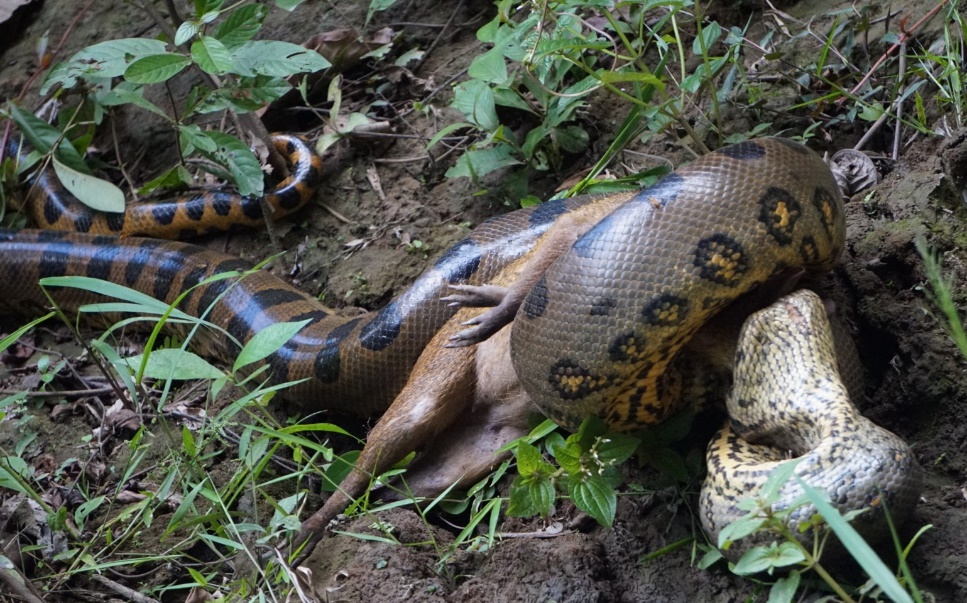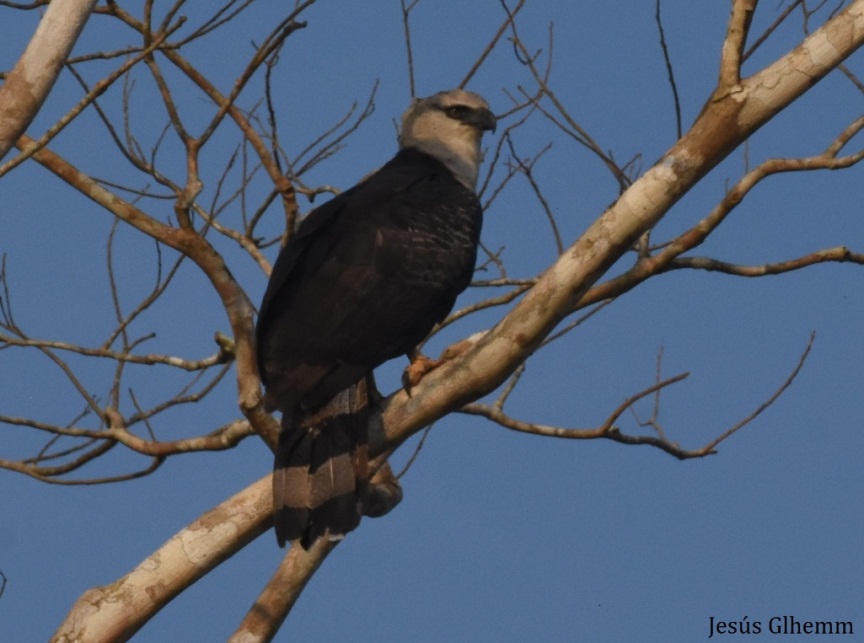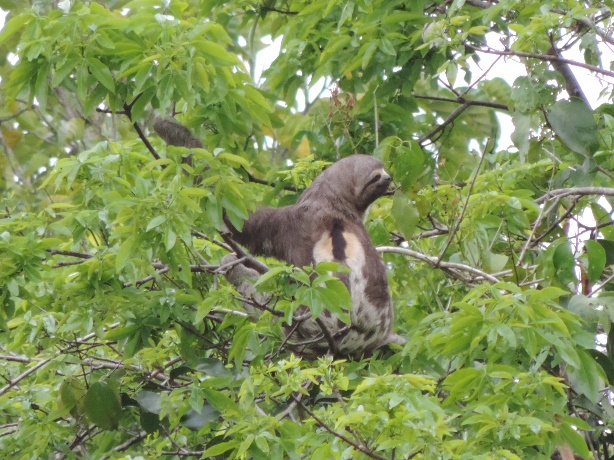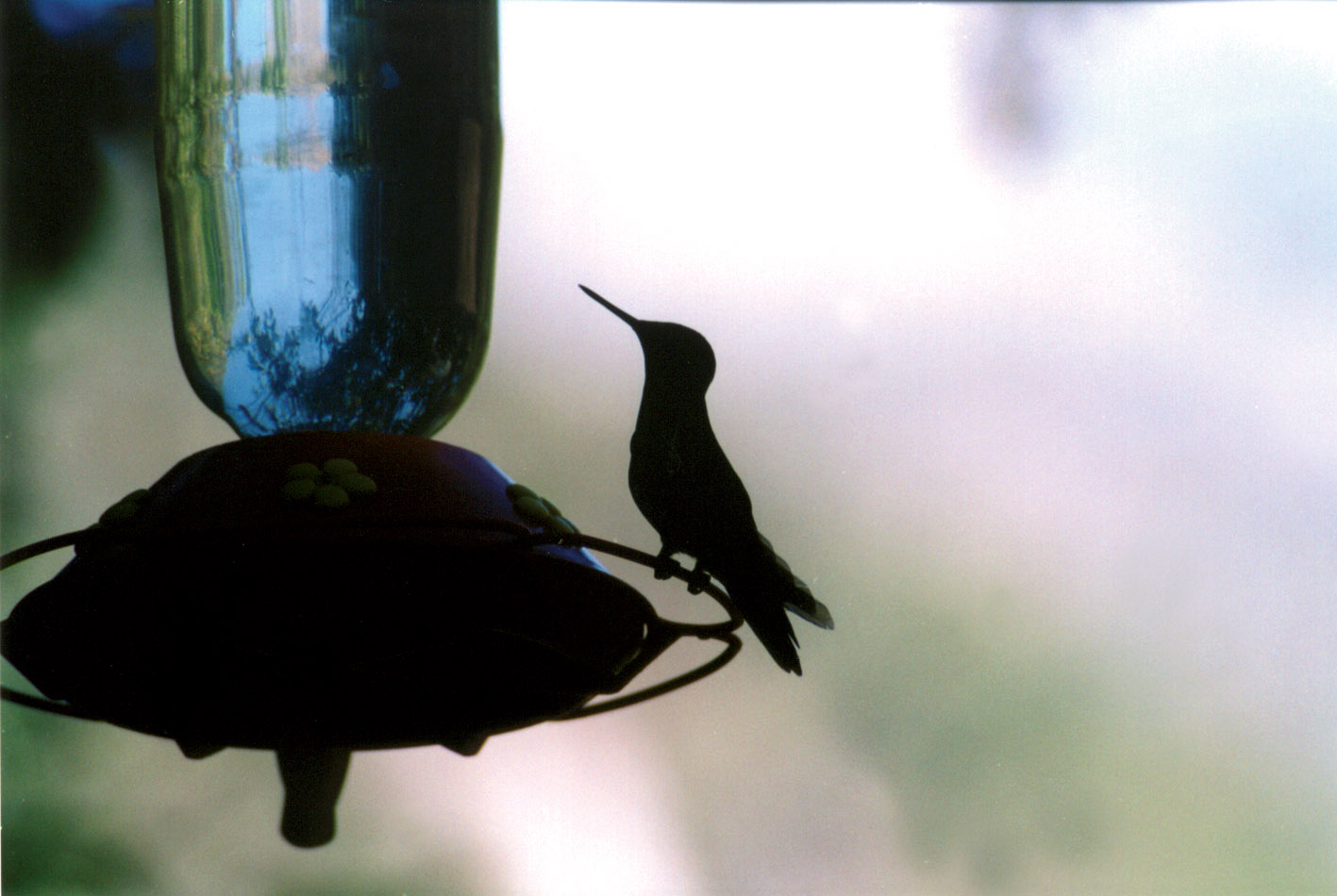16/12/2016
This month has been super busy for our Explorer Guides with some exciting rare sightings of rare wildlife species. We’ve been lucky enough to have several spottings recently, which have been featured in our newsletter, but here is a little bit more information in case you missed it. From Snakes to Sloths, we’ve included a few fun facts about our favourite friends.
Anaconda

1. Slippery Snakes
Anacondas are the largest snakes of the genus Eunectes. They can grow up to thirty feet long and weigh up to 550 pounds; interestingly they actually continue to grow throughout their entire life. All members of the genus Eunectes (large, aquatic snakes) are found in South America, so there’s no surprise that one of our Guides spotted one slithering around.
2. Spotty and Dotty
The main part of their body tends to be dark green, which gives them great camouflage. But they do also have two rows of black spots all the way down their backs and then white marks on the side of their bodies.
3. Water Babies
An anaconda normally spends most of its life in the water where it can move around more easily. They can also stay under water for a whole ten minutes before they surface to get a breath of air, which makes them great predators in the water.
4. Hunting Habits
Anacondas can hunt on the waterbed, making them incredibly versatile. They like to eat fish, turtles, caimans, capybaras, pigs, jaguars, and deer – so they’re not fussy! A big meal can keep an anaconda snake going for a few weeks, so it won’t have to eat during this time. However, if they’re lasting off little snacks they’ll eat up to a staggering forty pounds of food a day.
Harpy Eagle

1. Female Bosses
The world’s largest and most powerful eagle, the harpy eagle, boasts rear talons that are the same size as a grizzly bear’s! The females can weigh up to twice as much as a male, so we know who has the power in their relationships.
2. Home Sweet Home
Harpy eagles can be found in Neotropical rainforest from South Mexico all the way down to Northern Argentina. Even though they are big birds of prey, these eagles actually live at low elevations, as they can find prey more easily.
3. From White to Black
For the first five years of its life the harpy eagle has white feathers and these gradually turn black when the eagle reaches adulthood. This change helps harpy eagles identify when a bird is old enough to mate. It is believed that harpy eagles stay with the same companion for life.
4. Endangered Eagles
Sadly, harpy eagles are disappearing rapidly across South America mainly due to the threat on their natural habitat and hunters shooting these amazing creatures. In Central America, the largest known breeding population is found in Panama and only one nesting pair has been observed in Belize. With this in mind, we were really lucky to spot one of these magnificent creatures and it also highlights how important the importance of our conservation ethos at Inkaterra.
Three Toed Sloths

1. Swinging from the tree tops
Sloths are most at home in the treetops, and they spend pretty much all of their time swinging from the tree tops with a powerful grip aided by their long claws. Sloths even sleep in the trees, with up to 15 and 20 hours of sleep a day – we know what species we’d prefer to be on a Monday morning!
2. A head turner
Three-toed sloths posses a skill that few other mammals have. They have extra neck vertebrae that allow them to turn their heads some 270 degrees, so these animals really can see everything from the tree tops.
3. The X Factor
Despite being renowned for their laziest, sloths do in fact have a hidden talent. The three-toed sloth releases a long, high-pitched call that echoes through forests and sounds like an “ahh-eeee.” This sound is so distinct that they are sometimes called after the sound and named ais, which is pronounced “eyes”.
4. A Family Affair
Sloths both mate and give birth whilst they’re hanging from the trees, so baby sloths are used to facing these terrifying heights from a young age. Impressively, three-toed sloth babies are actually seen clinging to their mothers for the first nine months of their lives. Even if they’re used to the heights, it seems that they aren’t brave enough to try swinging for themselves straight away!
Jaguar

1. Big Cats
Jaguars are the largest big cats found in South America and the third largest cats in the world. Adult jaguars can weigh between 45 and 113 kilograms. From the top of their nose to the end of their tail, a jaguar can grow up to huge two and a half metres long.
2. Lone Rangers
Originally jaguars were found in South America all the way up to the US-Mexican border but now they are rarely seen that far up. Jaguars tend to wander around all alone and they mark their territory with their waste or clawing trees in order to ward off other animals.
3. The names Onca, Panthera Onca
On a factual note, the jaguar’s scientific name is Panthera onca, which is why they are often confused with panthers. However, our favourite fact about their name is that it comes from the Native American word yaguar, which means “he who kills with one leap”, which highlights the fierceness of these amazing animals.
4. Seeing spots
A jaguar’s coat is normally yellow and tan, but the colour of their markings can vary and some are reddish brown and even black. The spots on the coat are more solid and black on the head and neck. They travel all down the cat’s body and back, before becoming larger rosette-shaped patterns along the side and back of the body.
Green and White Hummingbird

1. A Local
The green and white hummingbird is commonly found in Peru and inhabits humid forests, forest borders, clearings, and second growth. They frequently breed near Pasco and Machu Picchu, which explains why we had a spotting near Machu Picchu Inkaterra Hotel.
2. Teeny Tiny
These birds are definitely on the small side with the average size between 10 and 11 centimetres. The average male weighs 6 grams and an average female weighs 5.5g. The Explorer Guides really had to keep their eyes peeled with these tiny treasures!
3. The Menu
Their diet consists of nectar from flowers and small insects, for example aphids and spiders. If they’re feeling adventurous sometimes they go for pollen and sap. Hummingbirds eat loads of small meals a day and up to twelve times their own body weight in nectar each day.
4. A Humdinger!
The hummingbird is famous for the “humming” sound that is created from the rapid beat of their wings, which can be up to 55 times a second. They move so fast that the wings actually appear blurred! They are the only bird species that can hover, fly backwards and even fly upside down.
An amazing video was uploaded by the Cornell University Lab of Ornithology and can be seen here.
